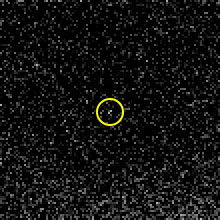Albiorix (moon)
 Composite image of Albiorix from 2010 observations by the Wide-field Infrared Survey Explorer (WISE) spacecraft | |
| Discovery[1] | |
|---|---|
| Discovered by | M. J. Holman et al. |
| Discovery date | 19 December 2000 |
| Designations | |
Designation | Saturn XXVI |
| Pronunciation | /ˌælbiˈɒrɪks/ |
Named after | Mars Albiorix |
| S/2000 S 11 | |
| Adjectives | Albiorigian /ˌælbiəˈrɪdʒiən/[2] |
| Orbital characteristics[3] | |
| Epoch 2000 Feb. 26.00 | |
| 16.182 Gm | |
| Eccentricity | 0.4770 |
| 783 d (2.15 yr) | |
| Inclination | 34.207° |
| Satellite of | Saturn |
| Group | Gallic group |
| Physical characteristics | |
Mean diameter | 28.6±5.4 km[4] |
| 13.33±0.03 h[5] | |
| Albedo | 0.062±0.028[4] |
Spectral type | light red (varying) B−V=0.89, R−V=0.50[6] |
Albiorix /ˌælbiˈɒrɪks/ is a prograde irregular satellite of Saturn. It was discovered by Holman and colleagues in 2000, and given the temporary designation S/2000 S 11.[7][8][9]
Albiorix is the largest member of the Gallic group of irregular satellites.
Name[]
It was named in August 2003[10] for Albiorix, "a Gallic giant who was considered to be the king of the world."[11] The name is known from an inscription found near the French town of Sablet which identifies him with the Roman god Mars (an interpretatio romana).[12]
Orbit[]

Albiorix orbits Saturn at a distance of about 16 million km and its diameter is estimated at 32 kilometers, assuming an albedo of 0.04. The rotation period was measured by the ISS camera of the Cassini spacecraft to 13 hours and 19 minutes.[13]

The diagram illustrates the Albiorigian orbit in relation to other prograde irregular satellites of Saturn. The eccentricity of the orbits is represented by the yellow segments extending from the pericentre to the apocentre.
Given the similarity of the orbital elements and the homogeneity of the physical characteristics with other members of the Gallic group, it was suggested that these satellites could have a common origin in the break-up of a larger moon.[6][9]
Physical characteristics[]
Varying colours revealed recently suggest a possibility of a large crater, leading to an alternative hypothesis that Erriapus and Tarvos could be fragments of Albiorix following a near-break-up collision with another body.[14]
References[]
- ^ Discovery Circumstances (JPL)
- ^ Albiorigi in Guy Barruol (1967) "Mars NABELCVS et Mars ALBIORIX," Ogam: tradition celtique, vol. 15, p. 358
- ^ from JPL
- ^ a b Grav, T.; Bauer, J. M.; Mainzer, A. K.; Masiero, J. R.; Nugent, C. R.; Cutri, R. M.; et al. (August 2015). "NEOWISE: Observations of the Irregular Satellites of Jupiter and Saturn" (PDF). The Astrophysical Journal. 809 (1): 9. Bibcode:2015ApJ...809....3G. doi:10.1088/0004-637X/809/1/3. S2CID 5834661. 3.
- ^ Denk, T.; Mottola, S. (2019). Cassini Observations of Saturn's Irregular Moons (PDF). 50th Lunar and Planetary Science Conference. Lunar and Planetary Institute.
- ^ a b Grav, T.; Holman, M. J.; Gladman, B. J.; Aksnes, K.; Photometric survey of the irregular satellites, Icarus, 166 (2003), pp. 33–45
- ^ IAUC 7545: S/2000 S 11 19 December 2000 (discovery)
- ^ MPEC 2000-Y13: S/2000 S 11 19 December 2000 (discovery and ephemeris)
- ^ a b Gladman, B. J.; Nicholson, P. D.; Burns, J. A.; Kavelaars, J. J.; Marsden, B. G.; Holman, M. J.; Grav, T.; Hergenrother, C. W.; Petit, J.-M.; ; and ; Discovery of 12 satellites of Saturn exhibiting orbital clustering, Nature, 412 (July 12, 2001), pp. 163–166
- ^ IAUC 8177: Satellites of Jupiter, Saturn, Uranus August 8, 2003 (naming the moon)
- ^ "Planet and Satellite Names and Discoverers". Gazetteer of Planetary Nomenclature. USGS Astrogeology. Archived from the original on 27 May 2010. Retrieved 2010-05-01.
- ^ Maier, Bernhard, Dictionary of Celtic religion and culture (1997), p. 11.
- ^ T. Denk, S. Mottola, et al. (2011): Rotation Periods of Irregular Satellites of Saturn. EPSC/DPS conference 2011, Nantes (France), abstract 1452.
- ^ Grav, T.; and Bauer, J.; A deeper look at the colors of Saturnian irregular satellites
- Ephemeris from IAU-MPC NSES
External links[]
- Gallic group
- Moons of Saturn
- Irregular satellites
- Discoveries by Matthew J. Holman
- Astronomical objects discovered in 2000
